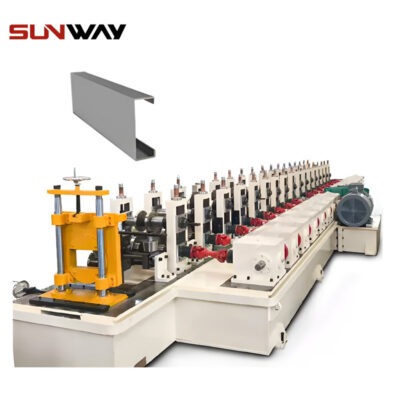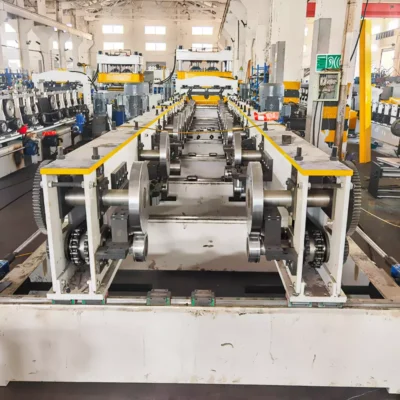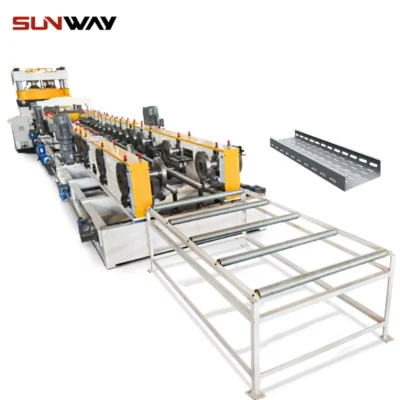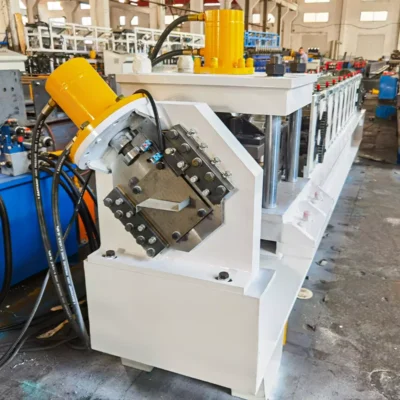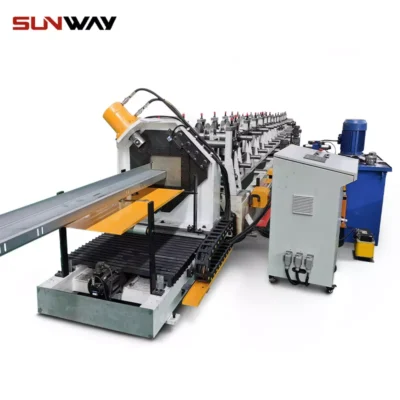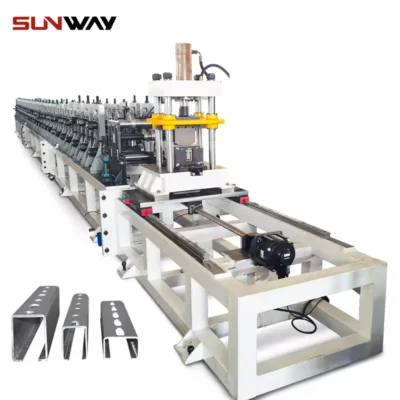Scaffolding is the backbone of construction, providing temporary support for workers and materials during building, maintenance, and repair. As industries demand faster, safer, and more cost-effective scaffolding solutions, the Scaffolding Component Roll Forming Machine has emerged as a game-changer.
These machines are designed to create high-strength, lightweight, and precisely formed components that make up scaffolding systems. Whether you’re a scaffolding manufacturer or a construction company looking to streamline operations, this guide will cover everything you need to know.
What is a Scaffolding Component Roll Forming Machine?
A Scaffolding Component Roll Forming Machine is advanced equipment engineered to produce structural components for scaffolding systems. It can efficiently manufacture a variety of parts, including tubes, couplers, braces, frames, and planks. These machines use the roll-forming process, which involves feeding metal sheets or coils through a series of rollers to shape them into the desired cross-sectional profile.
The result is high-quality scaffolding components that meet stringent safety standards, making them suitable for use in construction, industrial maintenance, and even large-scale infrastructure projects. With roll-forming technology, manufacturers can produce scaffolding components at high speeds, ensuring both cost efficiency and consistent quality.
Applications of Scaffolding Component Roll Forming Machines
Scaffolding systems are integral to various industries, and roll-formed components are the building blocks of these structures. Let’s explore the key applications:
1. Construction and Building Projects
- Use Case: Scaffolding systems made with roll-formed components provide temporary support during construction.
- Why It Matters: High-precision components ensure safety and stability, even on high-rise buildings.
2. Industrial Maintenance
- Use Case: Scaffolding is used for maintenance and repair in factories, refineries, and power plants.
- Why It Matters: Roll-formed components are lightweight yet strong, making it easy to assemble and disassemble scaffolding quickly.
3. Shipbuilding and Marine Applications
- Use Case: Scaffolding supports ship construction and repairs in shipyards.
- Why It Matters: Corrosion-resistant roll-formed components can withstand harsh marine environments.
4. Infrastructure Projects
- Use Case: Scaffolding is essential for bridge construction, highway repairs, and large-scale infrastructure projects.
- Why It Matters: Customizable roll-formed components allow for scaffolding systems tailored to complex structures.
5. Event and Stage Setups
- Use Case: Temporary scaffolding structures are used for stages, lighting rigs, and seating arrangements at events.
- Why It Matters: Roll-formed components provide the necessary strength while maintaining a sleek appearance.
Key Features of Wuxi Sunway Scaffolding Component Roll Forming Machines
When it comes to manufacturing scaffolding components, Wuxi Sunway Machinery offers cutting-edge roll-forming machines tailored to meet industry needs. Here’s what sets their machines apart:
1. Multi-Component Production
- What It Offers: Machines can produce a variety of scaffolding components, including pipes, braces, and frames, on a single production line.
- Why It’s Revolutionary: Eliminates the need for multiple machines, reducing setup time and factory space requirements.
2. High-Strength Material Compatibility
- Supported Materials:
- Galvanized steel
- Carbon steel
- Stainless steel
- Aluminum alloys
- Why It Matters: Ensures the production of components that meet both durability and weight requirements for scaffolding systems.
3. Precision Engineering
- What It Does: Produces components with tight tolerances and smooth finishes.
- Why It’s Important: Ensures that scaffolding systems are easy to assemble and meet stringent safety standards.
4. Integrated Punching and Cutting Systems
- Features: Servo-controlled punching and cutting units create holes and slots with high precision.
- Why It Matters: Reduces the need for secondary processes, saving time and costs.
5. High-Speed Production
- Performance: Capable of producing up to 20 meters of components per minute, depending on the design complexity.
- Why It Matters: Meets the high-volume demands of the construction industry.
6. Modular Design
- What It Includes: Machines are designed to integrate seamlessly with existing production lines.
- Why It Matters: Allows manufacturers to upgrade their systems as needed, ensuring long-term scalability.
7. Automated Quality Control
- The Technology: AI-powered sensors monitor production in real-time, ensuring consistent quality.
- Why It’s Revolutionary: Minimizes defects and reduces waste, improving overall efficiency.
8. Eco-Friendly Features
- What It Offers: Energy-efficient motors and waste-reducing technologies.
- Why It Matters: Supports sustainable manufacturing practices, reducing operational costs and environmental impact.

Production Workflow of a Scaffolding Component Roll Forming Machine
The production workflow for scaffolding components is streamlined for maximum efficiency and precision. Here’s a step-by-step breakdown:
1. Decoiling
- Raw metal coils are loaded onto the decoiler, which feeds the material into the machine.
2. Leveling
- A leveling system ensures the material is flat and free from warping before entering the roll-forming section.
3. Roll Forming
- The material passes through a series of rollers that gradually shape it into the desired profile.
4. Punching and Cutting
- Integrated punching units create slots, holes, or other features, while cutting systems trim the components to the required lengths.
5. Surface Treatment
- Some machines offer optional surface treatments like galvanization or powder coating to enhance corrosion resistance.
6. Stacking
- Finished components are automatically stacked for easy packaging and transportation.
Pricing of Scaffolding Component Roll Forming Machines
The cost of a Scaffolding Component Roll Forming Machine depends on its features, production capacity, and customization options. Below is a general pricing guide for 2025:
| Machine Type | Capabilities | Price Range (USD) |
|---|---|---|
| Standard Machines | Basic scaffolding component production | $150,000–$250,000 |
| High-Precision Machines | Advanced tolerances and multi-component output | $250,000–$400,000 |
| Fully Customizable Machines | Multi-profile and material capability | $400,000–$600,000 |
For tailored pricing and financing options, contact Wuxi Sunway Machinery.
Advantages of Using Scaffolding Component Roll Forming Machines
Investing in a Scaffolding Component Roll Forming Machine offers numerous benefits for manufacturers:
1. Enhanced Efficiency
- High-speed production reduces lead times and increases output.
2. Precision and Consistency
- Ensures uniform quality across all components, minimizing defects and assembly issues.
3. Material Versatility
- Supports a wide range of materials, including corrosion-resistant alloys.
4. Cost Savings
- Reduces material waste and labor costs, improving overall profitability.
5. Scalability
- High production capacity allows manufacturers to meet growing demands in the construction industry.
FAQs About Scaffolding Component Roll Forming Machines
| Question | Answer |
|---|---|
| What is the production speed? | Machines can produce up to 20 meters of scaffolding profiles per minute, depending on the design. |
| Can the machine handle heavy-duty materials? | Yes, it supports materials like carbon steel and high-strength alloys. |
| What is the typical lead time for delivery? | Delivery takes 3–6 months, depending on customization requirements. |
| Does Sunway provide after-sales support? | Absolutely! Wuxi Sunway offers training, maintenance, and troubleshooting services. |
| What is the machine’s lifespan? | With proper maintenance, the machine can last 10–15 years or more. |
| Is operator training included? | Yes, comprehensive training is provided with every machine purchase. |
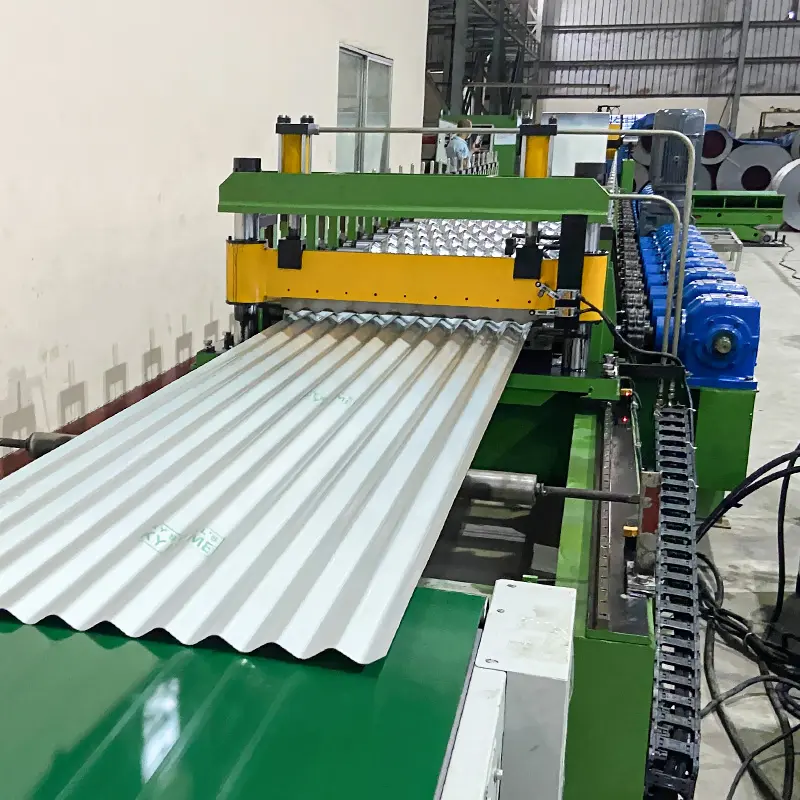
Global Trends Driving the Adoption of Scaffolding Component Roll Forming Machines
As construction and industrial projects grow in scale and complexity, the demand for high-quality scaffolding systems is on the rise. These macro-trends are fueling the adoption of Scaffolding Component Roll Forming Machines in 2025:
1. Rise in Mega Infrastructure Projects
- What’s Happening: Governments worldwide are investing in large-scale infrastructure projects, including highways, bridges, airports, and railways.
- Impact on Scaffolding Systems: These projects require scalable and modular scaffolding solutions that can adapt to complex structures.
- Why It Matters: Roll-forming machines enable manufacturers to produce diverse scaffolding components at high volumes, meeting the unique demands of mega projects.
2. Growth of Urbanization
- The Trend: By 2030, over 60% of the global population is expected to live in urban areas, driving demand for residential and commercial construction.
- Impact on Scaffolding Manufacturing: Urban construction projects require lightweight, easy-to-assemble scaffolding systems for high-rise buildings and limited spaces.
- Why It’s Exciting: Roll-forming machines produce precision-engineered components that simplify on-site assembly and reduce construction timelines.
3. Focus on Worker Safety
- The Push: Regulatory bodies are enforcing stricter safety standards for scaffolding systems to protect workers and minimize accidents.
- Impact on Component Design: Components must meet stringent quality and durability standards to ensure structural stability.
- Why It Matters: High-precision roll-forming machines ensure consistent quality, helping manufacturers comply with global safety regulations.
4. Adoption of Modular Construction
- The Context: Modular construction methods are gaining popularity due to their cost efficiency and faster project timelines.
- Impact on Scaffolding Systems: Modular construction requires scaffolding components that are easy to transport, assemble, and disassemble.
- Why It’s Relevant: Roll-forming machines produce lightweight and modular components that align perfectly with this trend.
5. Sustainability Goals in Construction
- The Numbers: The construction industry accounts for nearly 40% of global CO2 emissions, prompting a shift toward sustainable practices.
- Impact on Scaffolding Production: Manufacturers are seeking eco-friendly materials and processes to reduce their environmental footprint.
- Why It’s Important: Roll-forming machines optimize material usage and support the production of recyclable scaffolding components.
Technological Innovations in Scaffolding Component Roll Forming Machines
The evolution of Scaffolding Component Roll Forming Machines is being driven by technological advancements that enhance efficiency, precision, and sustainability. Here’s a closer look at the innovations shaping the future:
1. AI-Powered Quality Control
- What It Does: Artificial intelligence monitors the production process, identifying defects in real-time and ensuring consistent quality.
- Benefits:
- Reduces waste by catching errors early.
- Improves the reliability and safety of scaffolding components.
- Enhances customer satisfaction with defect-free outputs.
2. IoT-Enabled Smart Machines
- How It Works: IoT sensors collect real-time data on machine performance, material usage, and output quality.
- Advantages:
- Enables remote monitoring and diagnostics.
- Provides predictive maintenance alerts to prevent downtime.
- Optimizes production efficiency through data-driven insights.
3. Servo-Driven Roll Forming
- The Technology: High-speed servo motors control the rollers and cutting units with exceptional accuracy.
- Why It’s Important:
- Ensures consistent dimensions and smooth finishes.
- Reduces material waste, improving cost efficiency.
- Enhances the structural quality of scaffolding components.
4. Multi-Component Production Lines
- What It Offers: Machines can produce multiple scaffolding components (e.g., pipes, braces, frames) on a single line.
- Why It’s Revolutionary:
- Streamlines production processes.
- Reduces the need for additional machinery.
- Increases overall factory efficiency.
5. Advanced Welding and Seam Optimization
- The Innovation: Integrated welding systems create seamless joints for hollow scaffolding components.
- Why It Matters:
- Eliminates secondary welding operations, saving time and costs.
- Produces stronger, more durable components.
- Enhances safety by minimizing weak points.
Environmental Impact of Scaffolding Component Roll Forming Machines
Sustainability is no longer optional—it’s a necessity. Here’s how Scaffolding Component Roll Forming Machines contribute to greener manufacturing:
1. Waste Reduction
- How It Works: The roll-forming process optimizes material usage, minimizing scrap and waste.
- Impact: Conserves raw materials and reduces production costs.
2. Energy Efficiency
- The Innovation: Machines are equipped with energy-efficient motors and systems that consume less electricity.
- Why It Matters: Supports manufacturers in reducing their carbon footprint and operational costs.
3. Recyclable Outputs
- The Advantage: Components made from galvanized steel and aluminum are fully recyclable, contributing to a circular economy.
- Why It’s Important: Aligns with global sustainability goals and reduces landfill waste.
4. Localized Production
- What It Does: Enables manufacturers to produce scaffolding components locally, reducing the environmental impact of transportation.
- Outcome: Enhances regional sustainability while supporting local economies.
Comparison: Scaffolding Component Roll Forming Machines vs. Traditional Methods
Let’s compare Scaffolding Component Roll Forming Machines with traditional manufacturing methods like stamping or manual welding:
| Feature | Roll Forming Machine | Traditional Methods |
|---|---|---|
| Precision | High; ensures consistent dimensions | Moderate; prone to human error |
| Production Speed | High; up to 20 meters per minute | Slow; labor-intensive processes |
| Automation | Fully automated with IoT integration | Mostly manual or semi-automated |
| Material Waste | Minimal; optimized processes reduce scrap | Higher; less efficient material usage |
| Customization | Easily customizable for various profiles | Limited flexibility; requires separate tooling |
| Cost Efficiency | Higher initial cost, lower operational costs | Lower initial cost, higher long-term costs |
| Scalability | Ideal for mass production | Limited scalability for high-volume demand |
Additional FAQs About Scaffolding Component Roll Forming Machines
| Question | Answer |
|---|---|
| What is the machine’s production capacity? | Machines can produce up to 20 meters of scaffolding profiles per minute, depending on design complexity. |
| Can the machine produce custom components? | Yes, multi-profile capabilities allow for customizable designs. |
| What is the typical lead time for delivery? | Delivery takes 3–6 months, depending on customization requirements. |
| Does Sunway provide operator training? | Yes, comprehensive training is included with every machine purchase. |
| Can the machine process corrosion-resistant materials? | Yes, it is designed to handle materials like galvanized and stainless steel. |
| What is the lifespan of the machine? | With proper maintenance, the machine can last 10–15 years or more. |
Why Choose Wuxi Sunway Machinery for Scaffolding Component Roll Forming Machines?
Here’s why Wuxi Sunway Machinery is the trusted partner for scaffolding manufacturers worldwide:
- Proven Expertise: Decades of experience in designing and delivering innovative roll-forming solutions.
- Global Reach: Trusted by customers across Asia, Europe, and the Americas.
- Customization Excellence: Machines tailored to meet specific scaffolding designs and material requirements.
- Sustainability Commitment: Eco-friendly designs that minimize waste and reduce energy consumption.
- Innovation Leadership: Cutting-edge features like AI-driven quality control, IoT integration, and servo-driven systems.
- Comprehensive Support: From installation to troubleshooting, Sunway ensures seamless operations and customer satisfaction.
Conclusion: Building Safer, Smarter Scaffolding Systems
The Scaffolding Component Roll Forming Machine is revolutionizing the construction industry by enabling the efficient production of durable, lightweight, and customizable scaffolding components. Whether for high-rise buildings, industrial maintenance, or large-scale infrastructure projects, these machines deliver the precision, speed, and scalability needed to meet modern demands.
Ready to elevate your scaffolding production? Contact Wuxi Sunway Machinery today to explore their advanced roll-forming solutions. Together, let’s build the future of construction—one scaffolding component at a time!




